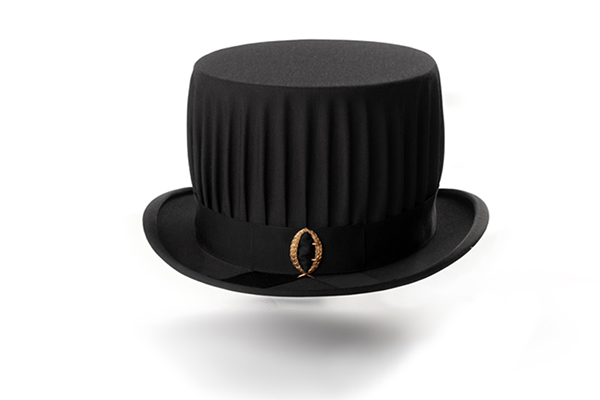The fact that all higher education institutions postponed their conferment ceremonies during the spring may have a long-term impact on being able to order a Swedish doctoral hat.
“Yes, it is certainly a strange situation for us. Many people are not ordering a doctoral hat because the conferment ceremonies are not happening,” says Lisa Franzén, a master hatter at Franzéns Hattmakeri. “It doesn’t look bright for the next six months. Some universities have even postponed their conferment ceremonies until 2022.”
The doctoral hat, the doctoral ring, and the diploma are the three insignia which show that a person has obtained a Degree of Doctor.
Customised for each individual
Caption: The brim is made of heavy cotton fabric. Flakes of shellac are melted into the fabric to make it stiff.
The doctoral hat is made to order according to the person’s head dimensions and there are only two hatters in Sweden with journeyman and master certificates in the craft. They make these hats according to a method developed in France in the mid-1800s and the tools, methods and materials that they use have remained virtually unchanged since then.
“The tools we use have often been handed down for generations. They are no longer made and we have to repair them ourselves when they break.”
Complex process
Lisa Franzén says that the doctoral hat is too complex for manufacture by machine.
“Everyone has a different head shape – often oval in various ways – and for a hard hat to sit comfortably, it must be fitted to the wearer’s head shape. In addition, it is complex and difficult to produce a hat that is not round with a machine. So it is hardly a commercially viable product.”
Caption: The body of the hat is made of thin cotton fabric dipped in water-based lacquer to make the fabric stiff. When the fabric has dried, the parts are cut out using customised templates. The parts are then assembled over a hat block corresponding to the customer’s head size.
Cloth purchased every four years
Every little detail of the doctoral hat is custom-made and the materials must be ordered in large batches for them to be produced. For example, the Swedish doctoral hat models are covered with rep cloth, which uses a weaving technique where the warp forms a pattern, and the black band around the hat and the bow must be made using grosgrain ribbon, which has selvages (higher thread density) along both long sides.
“We buy in the cloth every four or five years. Since the cloth is only used in the Swedish doctoral hat, we have to order and buy a whole batch of it in order to get someone to make the cloth.”
Two traditions
The doctoral hat has looked different in different periods down through the centuries from when the tradition arose in the late 16th century. In the 19th century, the doctoral hat was similar to the one we use today, but today’s doctoral hat only got its current appearance after the first part of the 20th century.
In Sweden there are two main traditions of doctoral hat: the model used at Uppsala University and at most other universities in Sweden; and the model used at Lund University and some other higher education institutions in southern Sweden. The Lund doctoral hat differs in that its brim is pleated and on the back there is a small bow and two ribbons.
The different faculties are marked by the shape of the buckle, with the exception of the Faculty of Theology which has no buckle, just a black bow.
Only for those who are being conferred
The doctoral candidate holds the hat in their hand in the procession and only dons the hat when the faculty’s degree conferrer starts their part of the conferment. This is also marked by a two-cannon salute that can be heard over much of Uppsala.
Lisa Franzén tells us that they are very careful not to deliver any doctoral hats without first checking with the higher education institution.
“Only those whose doctoral degrees have been awarded have the right to wear the doctoral hat and I see myself as a protector of the insignia, even if some who have just begun their doctoral studies get frustrated when they cannot place an order. But the doctoral hat is not a commercial product.”
Doctoral hat under threat from the pandemic
Lisa Franzén talks about the problems of being able to preserve the skills and knowledge of how to make a doctoral hat now that orders have fallen due to cancelled or postponed conferment ceremonies. “Most of our sales come from doctoral hats and the planning is often 18 months in advance so that we can order all the special materials required.
“I’m proud to be something as nerdy as a hatter and my apprentice and I are almost the only ones passing on a whole cultural heritage in Sweden. The doctoral hat is part of a tradition that we should be proud of. The Conferment Ceremony is not just any old event. It is a ceremony that we should be hold in high regard.
“As hatters, we can change to make other products – the Swedish government’s support measures require that you make changes to your business – but what happens then to the Swedish doctoral hat and the traditions it stands for?”
